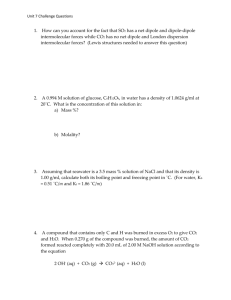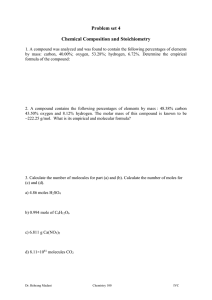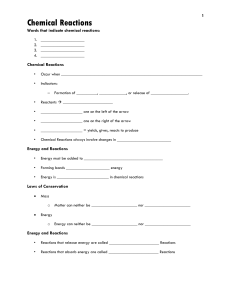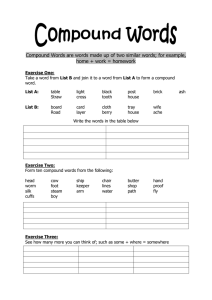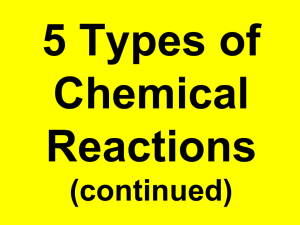Matter Types…And Changes
advertisement
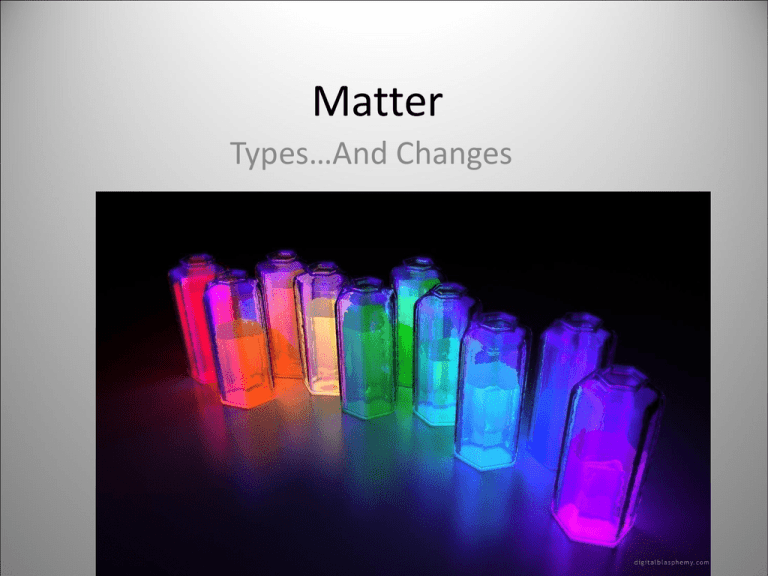
Matter Types…And Changes CHM 1010 PGCC Barbara A. Gage Matter • Mixture – material with two or more components with variable composition • Solution – material with two or more components homogeneously mixed; can have variable proportions of the components • Pure substance – material with a constant chemical composition Physical Separation Techniques • • • • • • • • What property is each technique based on? Dissolving Evaporating (evaporation) Filtering (filtration) Chromatography Sieving sifting straining Subliming (sublimation) Distilling (distillation) Extracting (extraction) CHM 1010 PGCC Barbara A. Gage Types of Matter • Element - the simplest type of substance with unique physical and chemical properties. It cannot be broken down into any simpler substances by physical or chemical means. • Compound - a substance composed of two or more elements which are chemically combined. Figure 2.19 The distinction between mixtures and compounds. Silberberg S Fe Physically mixed therefore can be separated by physical means; in this case by a magnet. Allowed to react chemically therefore cannot be separated by physical means. CHM 1010 PGCC Barbara A. Gage Types of Matter • Atom – smallest unit of an element with all the characteristics of the element Types of Matter • Molecule - a structure that consists of two or more atoms that are chemically bound together and thus behaves as an independent unit; smallest characteristic unit of a compound that retains the properties of the compound Figure 2.1 Silberberg The boxes here contain submicroscopic views of particles. Indicate which box(es) contain the stated item(s) and why. a.only elements b.one compound c.mixture of compounds d.molecules a. b. c. d. B, C, E A (plus an element), D F All but E Element Names and Symbols • Each element has a name and 1, 2 or 3 letter abbreviation called a symbol. The first letter in a symbol MUST be capital and the other(s) lowercase. • • • • hydrogen carbon sodium lead H C Na Pb helium He cobalt Co potassium K mercury Hg Image from WebElements Element Names and Symbols • Number of elements – 117 (#117 has not been identified but 118 has) CHM 1010 PGCC Barbara A. Gage Chemical Formulas • Some elements appear in nature bonded to each other. These are referred to as diatomic or polyatomic molecules. H2, O2, N2, F2, Cl2, Br2, I2 C60, S8, P4 • The 2 in O2 is termed a subscript and refers to the element immediately in front of it. Chemical Formulas • CO2 contains 1 atom of carbon and two atoms of oxygen all chemically linked. • H2SO4 contains 2 hydrogen, 1 sulfur, and 4 oxygen atoms. • (NH4)2C2O4 - A subscript outside parentheses applies to everything within the parentheses; 2 N, 8 H, 2 C, 4 O Chemical Formulas • How many atoms of each type are in the following compounds? • K2CO3 • Ca3(PO4)2 • C6H4COOHCOC2H5 • AlK(SO4)2.12H2O Chemical Reaction • Chemical change = chemical reaction Changes may be visible: • color change • cloudiness (precipitation) • gas formed (bubbles and/or odor) • reactant decreases (without dissolving) • energy is released or absorbed Chemical Equations • Chemical changes can be written symbolically. The symbolic representation is called a chemical equation. Carbon reacts with oxygen to form carbon dioxide. C + O2 CO2 reactants products Chemical Equations • Reaction arrows can go in either direction: 2 H2 + O2 2 H2O • Or both directions: NH4OH NH3 + H2O Or… Chemical Equations • Because of the Law of Conservation of Matter, you must account for all atoms in a chemical change. Carbon reacts with oxygen to form carbon monoxide. C + O2 CO 2C + O2 2 CO Equation is now balanced. coefficient Chemical Equations • A sample of propane, C3H8, when ignited with oxygen produces carbon dioxide and water. C3H8 + O2 C3H8 + 5 O2 CO2 + H2O 3 CO2 + 4 H2O Chemical Equations • Balance the following: CaCl2 + Na2CO3 NaCl + CaCO3 C3H8O2 + H2SO4 O2 + CO2 + H2O KOH K2SO4 + H2O Chemical Equations • If you have information on the states of matter, that can be added to the equation. s = solid l = liquid g = gas aq = aqueous Aqueous silver nitrate reacts with aqueous potassium chloride to form solid silver chloride and aqueous potassium nitrate. AgNO3 (aq) + KCl (aq) AgCl (s) + KNO3 (aq) Before • Write the balanced chemical equation for the change in the boxes. After Balancing Tips… • Balance polyatomic ions (units) that stay intact as a single unit. • Leave hydrogens and oxygens to the last (oxygen very last). • Be sure to reduce the coefficients to the smallest whole numbers. Types of Reactions • 1) Combination or Synthesis • elements or (element + compound) or compounds ------> compound • Fe (s) + S (s) ------> FeS (s) • O2 (g) + 2 CO (g) ------> 2 CO2 (g) • H2O (l) + SO3 (g) ------> H2SO4 (aq) Types of Reactions • 2) Decomposition or Analysis • compound ------> elements or (element and compound) or compounds • 2 HgO (s) -----> 2Hg (l) + O2 (g) • 2 KBrO3 (s) -----> 2 KBr (s) + 3 O2 (g) • CaCO3 (s) ------> CaO (s) + CO2 (g) Types of Reactions • 3) Single Replacement element + compound --------> element + compound • Cu (s) + 2AgNO3 (aq) ----> 2Ag (s) + Cu(NO3)2 (aq) • Types of Reactions • 4) Double Replacement compound + compound —> compound +compound AgNO3 (aq) + NaCl (aq) —> AgCl (s) +NaNO3 (aq) Double Replacement Rxns: Solid forming AgNO3 (aq) + NaCl (aq) —> AgCl (s) +NaNO3 (aq) Gas-forming KHCO3 (aq) + HCl (aq) ----> KCl (aq) + CO2 (g) +H2O (l) Acid-Base HCl (aq) + KOH (aq) ----> KCl (aq) + H2O (l) Types of Reactions • 5) Oxidation-Reduction (redox) CH4 (g) + 2O2 (g) ----> CO2 (g) + 2H2O (l) 2Mg (s) + O2 (g) -----------> 2MgO (s) 4HCl (aq) + 3FeCl2 (aq) + KMnO4(aq) --> MnO2(s) + KCl(aq) + 3FeCl3(aq) + 2H2O(l) Investigation of Chemical Reactions • Let’s finish the lab by writing the balanced chemical equations and determining the reaction types: 1. Mg + HCl 2. Mg (heat) 3. CoCl2 + Na3PO4 4. Fe + CuSO4 5. KClO3 (heat) 6. CuCO3 (heat)
